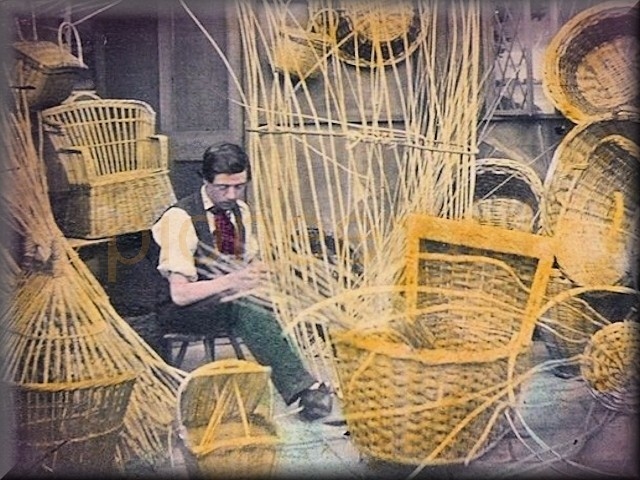basket

A vessel made of twigs, rushes, splinters, or other flexible things, interwoven. The contents of a basket; as much as a basket will contain. — Webster, 1882
 The Fourth of July. The Fourth of July will be fittingly observed in the timber between lakes Henry and Thompson. A program consisting of speaking, music, etc., will be carried out, after which dinner from baskets will be in order. — Kingsbury County Independent, July 1895
The Fourth of July. The Fourth of July will be fittingly observed in the timber between lakes Henry and Thompson. A program consisting of speaking, music, etc., will be carried out, after which dinner from baskets will be in order. — Kingsbury County Independent, July 1895
 Most of the baskets mentioned in the Little House books are containers used by Ma and the girls for storage of needlework items. These baskets held sewing, knitting, and mending projects and materials, and they were brought out only when those projects are in progress.
Most of the baskets mentioned in the Little House books are containers used by Ma and the girls for storage of needlework items. These baskets held sewing, knitting, and mending projects and materials, and they were brought out only when those projects are in progress.
Baskets have been around as long as there have been dry items needing to be transported or stored, although baskets could also be used for non-storage usage, such as when sifting two substances of different sizes or for catching fish. If home-made, baskets were typically woven of materials readily available and could be as simple or as elaborate as the basket maker wanted them to be. In the photo shown, notice the variety of sizes and shapes of baskets in use. For the most part, baskets were not exclusive in design to their usage, although traditional shapes and sizes were prevalent and often became associated with a particular use. An open basket in which darning, knitting, or sewing items were kept could just as easily be used for the storage of foodstuffs, kindling, or garden seeds.
Laura’s sewing baskets.  At least two of Laura’s personal sewing baskets have been preserved, including this one on display at the Laura Ingalls Wilder Museum in Walnut Grove, Minnesota. There are two small handles on top for carrying. Another of Laura’s sewing baskets was on display in the old museum at Rocky Ridge, and may possibly be rotated into display in the new museum or placed in the farmhouse or rock house. Both baskets are purchased items and date to after Laura’s marriage.
At least two of Laura’s personal sewing baskets have been preserved, including this one on display at the Laura Ingalls Wilder Museum in Walnut Grove, Minnesota. There are two small handles on top for carrying. Another of Laura’s sewing baskets was on display in the old museum at Rocky Ridge, and may possibly be rotated into display in the new museum or placed in the farmhouse or rock house. Both baskets are purchased items and date to after Laura’s marriage.
 Mary’s blue bead basket. In These Happy Golden Years (see Chapter 4, “Sleigh Bells”), a blue-bead basket made by Mary Ingalls sits on Pa’s desk. What the basket is used for isn’t stated, nor its size or details of its construction. The bead project is attributed to Mary and is (at the time of this writing) on display in Mansfield. It is most likely a (hair) bun cover, not a basket, but is shown here because of its shape and blue beads!
Mary’s blue bead basket. In These Happy Golden Years (see Chapter 4, “Sleigh Bells”), a blue-bead basket made by Mary Ingalls sits on Pa’s desk. What the basket is used for isn’t stated, nor its size or details of its construction. The bead project is attributed to Mary and is (at the time of this writing) on display in Mansfield. It is most likely a (hair) bun cover, not a basket, but is shown here because of its shape and blue beads!
Indian baskets. In Little House on the Prairie (see Chapter 24, “Indians Ride Away”), Laura tells of the Osage riding on their ponies past their cabin, some of the women with babies in cradleboards or small children in baskets strapped to the pony’s sides. I have been unable to find an antique photograph of an Osage child being transported in a basket, but it sounds like a feasible way in which to travel with a toddler too old to be strapped to a traditional cradleboard!

basket (BW 8-9; FB 5, 10, 17, 20; LHP 24; BPC 37; SSL 3, 6, 26; LTP 7, 19; THGY 4, 33; PG)
blue-bead (THGY 4)
bushel (FB 10, 17, 23; LTP 7), see also bushel
darning (LTP 10)
Indian baby buried in (PG) – The episode described suggests a Sioux Indian tree burial, with the wrapped body possibly being protected with a woven a basket-like cover.
Osage baby/children riding in (LHP 24; PG)
knitting (SSL 19)
mending basket / mending-basket (BW 8-9; BPC 37)
picnic (FB 17) – A basket in which food to be eaten outdoors is transported.
workbasket (LTP 17; THGY 4)

